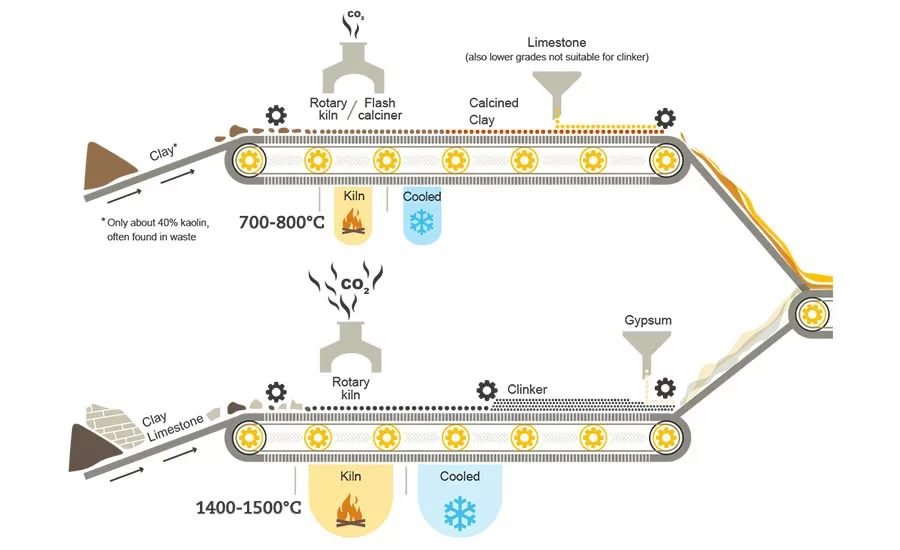LC3 Cement: Revolutionizing Sustainable Construction with Reduced Carbon Footprint
The construction industry is under increasing pressure to reduce its carbon footprint and contribute to global efforts to combat climate change. Cement, a crucial component in concrete production, is a major source of carbon emissions, and finding more sustainable alternatives is essential. Limestone Calcined Clay Cement (LC3) has emerged as a promising solution, offering a substantial reduction in greenhouse gas emissions compared to traditional Portland cement. In this article, we will explore the potential of LC3 and the challenges it faces in gaining widespread adoption, especially in the United States.
The LC3 Innovation
Developed by the LC3 Project, led by Karen Scrivener at the École Polytechnique Fédérale de Lausanne, Switzerland, LC3 is a cementitious material based on a blend of limestone and calcined clay pozzolan. Calcined clay, also known as metakaolin, is created by heating low-grade kaolinite clay to temperatures between 650°C and 750°C. Both limestone and low-grade clays are abundantly available, making LC3 a sustainable and environmentally friendly choice.
The most significant innovation of LC3 is the drastic reduction in clinker content. Clinker production accounts for the majority of carbon emissions in traditional cement manufacturing. In the LC3 formula, clinker content is reduced to just 50%, compared to the approximately 91% found in traditional Portland cement. The LC3 mixture includes 50% clinker, 30% calcined clay, 15% limestone, and 5% gypsum. This lower clinker content leads to a substantial reduction in the carbon footprint, making LC3 an attractive option for sustainable construction.
LC3 also contains a higher proportion of limestone compared to traditional Portland cement. While Portland cement typically includes up to 5% limestone, LC3 incorporates even more, further enhancing its sustainability. The synergy between these materials allows LC3 to perform similarly to ordinary Portland cement, and it achieves significant energy savings. The manufacturing process of calcined clays involves heating at approximately 700-800°C, far lower than the temperature required for clinker production (1400-1500°C).

Global Acceptance and Standards
LC3-50, with a clinker content of 50%, is widely promoted and accepted under cement standards applicable in various regions, including Europe, India, the U.S., Cuba, and much of South America. The LC3 Project, funded by the Swiss government and ClimateWorks Foundation, has actively advocated for its adoption.
Despite being widely accepted in some parts of the world, the use of LC3 in U.S. pavements, slabs, and structural concrete remains limited. In contrast, countries like India and South America have successfully embraced LC3 in low-rise concrete buildings, demonstrating its versatility and sustainability. Notable examples include the New Delhi office of the Swiss Agency for Development and Cooperation and Cementos Argos in South America, which have integrated LC3 into their construction projects.
Overcoming Challenges
Several challenges hinder the widespread adoption of LC3, particularly in the United States. The most significant obstacle is the substantial capital investment required by cement producers. Setting up a separate kiln line and a flash calcinator represents a heavy financial commitment, with costs potentially reaching $30 million to $40 million. Despite these challenges, cement producers are recognizing the potential environmental benefits and actively investigating LC3 production.
Addressing Technical Challenges
To further expand the adoption of LC3, it is essential to address various technical challenges. Selecting suitable clays and gathering long-term performance data for structural concrete are critical steps in the process. In the case of clays, not all are suitable for use in construction. For instance, clay with a high smectite or bentonite content may not be appropriate for structural purposes. Therefore, comprehensive research is required to identify the most suitable clays for use in LC3.
For structures, there is also a need for long-term performance data related to properties like creep, thermal behavior, rigidity, and fire resistance. These data are essential for gaining the trust of architects, engineers, and construction professionals when considering LC3 for critical applications. Additionally, there is currently no data available regarding the long-term behavior of post-tensioned concrete containing LC3.

The Importance of Location
Another key factor that can affect the carbon reduction benefits of LC3 is the proximity of the cement plant to the clay source. To maximize the advantages of LC3 over traditional Portland cement, the cement plant should be located near the clay source. This proximity reduces transportation-related emissions and ensures a more sustainable supply chain.
The Economic Barrier
Lionel Lemay, Executive Vice President of Structures and Sustainability at the National Ready Mixed Concrete Association, points out that the barriers to LC3 adoption in the U.S. are predominantly economic rather than technical. To encourage contractors and other stakeholders to use LC3, it is essential to address technical concerns and ensure there is minimal risk associated with its use. While the material holds great promise, gaining the trust of the construction industry will require ongoing efforts to resolve technical issues.
The Role of Education
For the widespread adoption of LC3, material producers and other stakeholders need to focus on educating architects and structural engineers about LC3 and how to specify it in construction projects. Building confidence in the material’s performance and sustainability is a crucial step in its acceptance.
Conclusion
Despite the challenges, LC3 represents a significant step forward in the pursuit of sustainable construction materials. With its reduced carbon footprint and ability to perform on par with traditional Portland cement, LC3 has the potential to revolutionize the construction industry’s sustainability efforts. Continued research and collaboration within the industry will play a pivotal role in making LC3 a cornerstone of sustainable construction practices in the years to come. While obstacles remain, the environmental benefits and long-term potential of LC3 make it a material worth investing in, both for the industry and the planet.





